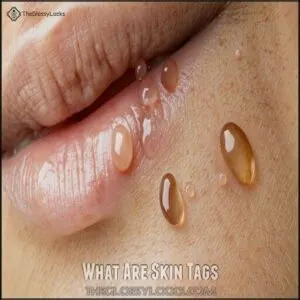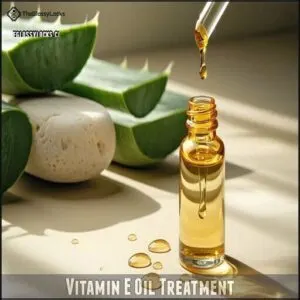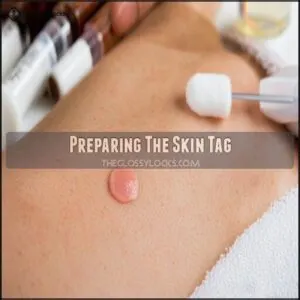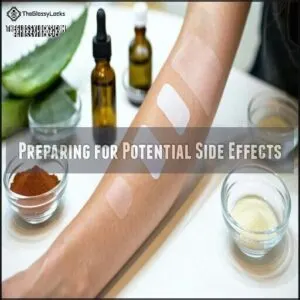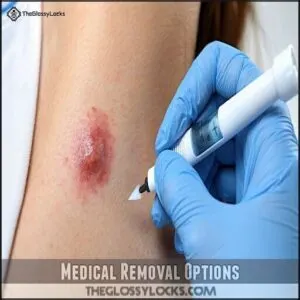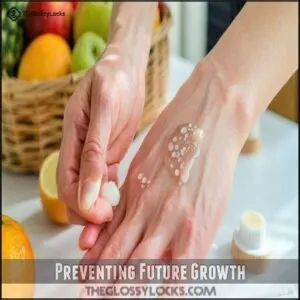This site is supported by our readers. We may earn a commission, at no cost to you, if you purchase through links.
 You can tackle those pesky skin tags at home with several effective natural methods.
You can tackle those pesky skin tags at home with several effective natural methods.
The best natural way to remove skin tags includes applying tea tree oil with a cotton ball 2-3 times daily, or using diluted apple cider vinegar for gradual breakdown.
Vitamin E oil works overnight to gradually shrink tags, while banana peel’s enzymes can help when rubbed on the area consistently.
Fresh garlic paste offers antimicrobial benefits when applied with care.
Always clean the area before treatment and stop if irritation occurs.
These gentle approaches might take longer than medical procedures, but they’ll help you wave goodbye to those unwanted skin companions.
Table Of Contents
- Key Takeaways
- What Are Skin Tags
- Natural Remedies Explained
- Removing Skin Tags Safely
- Medical Removal Options
- Preventing Future Growth
- Frequently Asked Questions (FAQs)
- Can home remedies remove skin tags?
- How do I get rid of a tag on my face?
- What are the best natural skin tag removers?
- How to treat skin tags?
- How to remove skin tags fast?
- How to get rid of a skin tag without a scar?
- How do you dissolve skin tags naturally?
- Can hydrogen peroxide get rid of skin tags?
- What are skin tags a warning for?
- Can you remove a skin tag yourself?
- Conclusion
Key Takeaways
- You can use tea tree oil by applying it to a cotton ball and placing it on the skin tag 2-3 times daily, with consistent application showing results in 2-4 weeks.
- You’ll find apple cider vinegar effective when diluted with equal parts water, applied via cotton ball for 15-30 minutes three times daily until the tag shrinks and falls off.
- You can accelerate results by placing banana peel’s inner side against the skin tag and securing it with medical tape, as its natural enzymes gradually break down the excess tissue.
- You’ll need to properly prepare the area before applying any remedy by thoroughly cleansing with mild soap, completely drying the area, and monitoring for any signs of irritation or infection.
What Are Skin Tags
You’ll notice those small, soft growths hanging from your skin folds are skin tags, harmless flesh-colored or brownish growths that commonly appear on your neck, armpits, eyelids, and other areas where skin rubs against skin.
Though they’re typically painless and benign, many people seek removal methods for cosmetic reasons or when these tiny stalked protrusions become irritated by clothing or jewelry.
Definition and Characteristics
Skin tags, medically known as acrochordons, are small, benign growths that appear as soft flaps attached to your skin by a narrow stalk.
These harmless formations can vary from tiny pinpoint dots to several centimeters in diameter, typically matching your skin tone or appearing slightly darker.
When identifying skin tags, look for these distinctive characteristics:
- Soft, mushroom-like growths with a smooth or irregularly textured surface
- Pendulum-like appearance with a narrow connecting stalk
- Flesh-colored or brownish coloration that blends with surrounding skin
Unlike moles or warts, skin tags have a unique composition of loose collagen fibers and blood vessels covered by normal skin. They’re generally painless unless they become irritated from rubbing against clothing or jewelry, which can cause irritation from rubbing.
Common Locations on The Body
Now that you understand what these small growths look like, let’s explore where they typically appear. Your body’s friction zones create perfect breeding grounds for skin tags.
| Location | Why They Form | Removal Difficulty |
|---|---|---|
| Neck & eyelids | Collar rubbing, facial creases | Moderate (visible area) |
| Armpits & groin | Warm, moist, high-friction areas | Easy (hidden location) |
| Under breasts | Skin-to-skin contact, moisture | Moderate (sensitive area) |
You’ll typically find these harmless growths in body folds where skin rubs against skin or clothing. Natural skin tag removal methods work equally well regardless of location, though visibility during treatment varies.
Prevalence and Risk Factors
Did you know that nearly 1 in 2 adults will develop skin tags during their lifetime? These harmless growths become increasingly common as you age, especially after hitting 40.
Your chances of developing skin tags depend on several key factors:
Your chances of developing skin tags depend on several key factors:
Genetics, friction, and hormones team up to create the perfect storm for skin tag formation.
- Age correlation – As the aging process advances, your skin loses elasticity, creating more favorable conditions for tags to form
- Weight influence – Excess pounds create additional skin folds where friction occurs, substantially increasing your risk
- Genetic factors – Having family members with skin tags puts you in the "likely to develop them" category
- Hormonal changes – Pregnancy, insulin resistance, and other hormonal fluctuations can trigger skin tag growth
Where skin rubs against skin or clothing, you’re basically creating the perfect environment for these growths. Maintaining skin firmness relies on dermal collagen structure, which can be affected by aging. While human papillomavirus (HPV) may play a role in some cases, everyday friction remains the primary culprit behind most skin tag symptoms.
Natural Remedies Explained
You’ll find that these natural substances work by breaking down tissue and interrupting blood flow to skin tags, often eliminating them within weeks.
These methods use common household items that contain enzymes, acids, and compounds which effectively target the excess skin growth without harsh chemicals, utilizing natural substances.
Tea Tree Oil Application
Now that you understand what skin tags are, let’s explore tea tree oil as a natural solution.
Tea tree oil offers a gentle approach for skin tag treatment, thanks to its antimicrobial properties. For best results, always dilute with a carrier oil like coconut oil (1:3 dilution ratio) to prevent skin sensitivity issues.
Apply the mixture with a cotton ball and secure with a bandage for 10 minutes, three times daily. Oil quality matters—choose 100% pure tea tree oil. You can find quality tea tree from various sources.
While some users report success after 2-4 weeks of consistent application frequency, results vary by person. Remember, consult your doctor before trying any home remedy.
Apple Cider Vinegar Method
While tea tree oil offers one solution, apple cider vinegar (ACV) presents another powerful option for skin tag removal. Though scientific backing remains limited, many users report success with this kitchen staple.
The high concentration of acetic acid may help, but there’s no scientific evidence supporting its efficacy.
For effective ACV application:
- Mix equal parts organic ACV and water to create a gentle dilution ratio that won’t harm your skin
- Soak a cotton ball thoroughly and secure it directly on the skin tag for 15-30 minutes
- Continue this routine three times daily until the tag shrinks and eventually falls off
The acetic acid in ACV gradually breaks down the excess tissue, with most people seeing complete results within 2-3 weeks of consistent treatment.
Before starting, always protect surrounding healthy skin with petroleum jelly to prevent irritation. If you experience more than mild tingling, discontinue use immediately. Your skin sensitivity may vary, so start with shorter application times and adjust as needed for safe, effective skin tag home treatment.
Banana Peel Technique
While apple cider vinegar works through acidity, the banana peel technique offers a gentler approach using natural enzymes for skin tag removal.
The inner side of banana peels contains powerful enzymes that gradually break down skin tags without harsh chemicals. Herbal skin remedies offer effective, gentle solutions.
Here’s how to maximize results:
| Application Duration | Peel Type | Expected Results |
|---|---|---|
| 30-60 minutes daily | Ripe, yellow | Gradual lightening |
| Overnight treatment | Overripe, spotted | Faster breakdown |
| 3-4 hours daytime | Fresh cut daily | Consistent progress |
| 10-15 minutes | Frozen peel | Less messy application |
You’ll need patience with this home remedy – secure the peel’s white side against your skin tag using medical tape, and replace with fresh peel daily. Most people notice results within 1-2 weeks, but discontinue if irritation occurs.
Garlic Paste Application
After exploring banana solutions, garlic offers a powerhouse approach to skin tag removal. This kitchen staple contains allicin, a potent compound that works wonders on unwanted skin growths.
Create your garlic preparation:
- Crush 2 fresh cloves into a smooth paste consistency
- Mix with half-teaspoon of olive oil to prevent irritation management
- Apply directly to the natural skin tag
- Cover with a bandage overnight
- Remove and rinse in the morning
Application frequency matters—most DIY treatments fail due to inconsistency. For expected results, use this natural remedy daily. You’ll typically see your skin tag shrinking within 3-4 days of consistent treatment.
Vitamin E Oil Treatment
Looking for a gentle approach to skin tag removal? Vitamin E oil offers a promising solution with its powerful antioxidant properties that promote healing.
| Application Technique | Treatment Duration | Efficacy Evidence |
|---|---|---|
| Apply directly with cotton swab | 2-3 weeks | Moderate clinical support |
| Cover with bandage overnight | Apply once daily | High anecdotal success |
| Perform patch test first | Results vary by individual | Minimal scarring reported |
| Clean area thoroughly before use | Continue until tag falls off | Safe for most skin types |
| Massage gently in circular motion | Monitor for skin sensitivity | Prevents future inflammation |
You’ll notice gradual softening and shrinking of your skin tags without harsh chemicals. Many users find that Vitamin E products enhance their skincare routine with powerful antioxidant properties that promote healing.
Removing Skin Tags Safely
You’ll need to make certain of proper identification and preparation before attempting any skin tag removal at home.
When choosing a natural remedy, select one that matches your skin sensitivity and the tag’s location, while keeping tools clean and having bandages ready for afterward.
This process requires careful consideration of complete concepts to ensure a safe and effective removal.
Preparing The Skin Tag
Why is proper preparation the secret to successful skin tag removal? Before applying any natural remedies, you’ll need to properly prepare the area for best results.
- Cleanse Area thoroughly with mild soap and warm water, then pat dry completely with a clean towel.
- Softening Tag through proper Hydration Importance helps natural remedies penetrate better.
- Exfoliation Benefits come from gently removing dead skin cells around (not on) the tag, creating a clean workspace for treatment.
Consistent sunscreen reapplication matters for protecting newly exposed skin.
Work in good lighting so you can clearly see the entire structure when applying home remedies.
Sterilize Tag surroundings to prevent infection during the skin tag removal process.
Choosing The Right Remedy
After preparing your skin tag area, choosing the right remedy depends on your specific situation.
When considering natural remedies, match the treatment to your skin sensitivity and tag characteristics:
Cost comparison reveals these home remedies are budget-friendly alternatives to medical procedures.
The remedy effectiveness varies by person, with smaller tags typically responding faster.
Remember, patience is key—consistent application over several weeks minimizes scarring potential while maximizing results.
These remedies offer a natural approach to removing skin tags, with consistent application being crucial for success.
The goal is to achieve maximizing results with minimal scarring, making these home remedies an attractive option for those seeking a non-invasive solution.
Preparing for Potential Side Effects
Taking five minutes to understand potential side effects can save you weeks of healing complications after skin tag removal.
Before applying any natural remedy, always conduct a patch test to identify possible allergic reactions and prevent skin damage.
- Watch for infection signs like unusual redness, warmth, or discharge that persists
- Monitor for excessive pain or bleeding that continues beyond initial treatment
- Check for inflammation or swelling that worsens rather than improves
- Document any skin irritation or sensitivity developing after application
- Keep the treatment area clean to minimize infection risks and support healing
If you notice these warning signs, stop treatment immediately and consult a healthcare provider. While natural remedies are generally gentle, they can still cause reactions depending on your skin type and remedy strength.
With proper irritation management and attention to early warning signs, you’ll minimize scarring and guarantee a smoother healing process without complications, ensuring a smoother healing process and reducing the risk of healing complications after skin tag removal, which is crucial for skin damage prevention and overall skin health.
Methods to Avoid
Now that you understand potential side effects, let’s talk about what methods you should absolutely avoid when dealing with skin tags.
While DIY solutions might seem tempting, some approaches can leave you worse off than when you started:
- Imagine snipping at a skin tag with unsterilized tools like scissors or fingernail clippers, only to watch it bleed profusely while introducing bacteria
- Picture applying harsh wart remover to your delicate facial skin, resulting in chemical burns and permanent scarring
- Visualize wrapping duct tape around a skin tag near your eye, causing irritation that spreads to your entire eyelid
Never attempt facial removal with abrasive scrubs or burning methods, as these sensitive areas can suffer serious skin damage.
Watch out for signs of infection—redness, warmth, or pus—and don’t ignore them hoping they’ll disappear. Many people seek professional skin tag removal due to concerns about irritation or discomfort.
When in doubt, put those scissors down and make an appointment with a dermatologist instead. Your skin will thank you!
Medical Removal Options
While natural remedies can be effective, you’ll sometimes need a doctor’s help for stubborn or numerous skin tags.
Medical procedures like freezing with liquid nitrogen, cutting with surgical scissors, or burning with electrocautery provide quick, permanent results when home treatments aren’t enough.
Snipping and Electrocauterization
Two effective medical techniques for skin tag removal involve snipping paired with electrocauterization.
Your dermatologist will first numb the area with local anesthetic before using sterilized tools for surgical removal.
The procedure takes just 15 minutes – the dermatologist treatment begins with quick excision at the tag’s base, followed by electrocautery to seal blood vessels and control bleeding.
You’ll experience minimal electrocautery pain and downtime.
Professional expertise guarantees proper cauterization, dramatically reducing both bleeding risks and scarring potential compared to home methods.
This procedure comparison shows why many choose medical intervention for stubborn skin tags requiring immediate, complete removal.
Cryotherapy and Side Effects
While snipping provides immediate results, cryotherapy offers another effective professional option for skin tag removal.
During this procedure, your dermatologist applies liquid nitrogen to freeze the skin tag, causing it to blister and fall off within 7-10 days.
Be aware of these cryotherapy risks:
- Temporary redness and minor swelling around the treated area
- Pigment changes that may affect surrounding skin
- Potential for minimal scarring at the treatment site
Though rare, nerve damage can occur if liquid nitrogen is applied incorrectly. Despite these considerations, cryotherapy remains one of the most reliable medical treatments for permanent skin tag removal, with FreezeAway being a common brand used in clinical settings.
Numbing Agents and Precise Electrocautery
While cryotherapy freezes skin tags off, electrocautery offers another professional solution with remarkable comfort. Before your procedure, your dermatologist will apply topical anesthetics containing lidocaine—effectively numbing the area and ensuring pain-free treatment.
Electrocautery stands out among medical procedures for these reasons:
- The precision tool uses controlled electrical current to target only the skin tag, leaving surrounding healthy tissue untouched for ideal scar prevention
- Your healing process typically completes within 5-7 days, requiring minimal aftercare
- Complication rates remain below 2%, making this considerably safer than DIY methods
You can enhance your comfort by applying over-the-counter numbing cream about 30 minutes before your appointment. Most patients describe the sensation as pressure rather than pain—making electrocautery a quick, effective solution for troublesome skin tags.
Preventing Future Growth
You can prevent future skin tags by making simple lifestyle changes that reduce friction in skin folds and maintaining healthy blood sugar levels through diet and exercise.
Regular monitoring of areas prone to skin tags will help you catch new growths early, when they’re easier to address with the natural remedies we’ve discussed.
Reducing Friction and Irritation
Breaking the cycle of skin tags begins with minimizing friction where skin meets skin.
To prevent new growths from forming, consider these practical steps:
- Choose loose-fitting clothing made from breathable fabrics like cotton to reduce skin rubbing in problem areas
- Apply talcum powder to keep skin folds dry, especially in warm weather when moisture accumulates
- Practice gentle cleansing techniques around sensitive areas prone to irritation
- Create protective barriers with petroleum jelly or anti-chafing balms before physical activities
- Wear moisture-wicking undergarments designed specifically for skin fold protection
These simple adjustments can substantially decrease your chances of developing new skin tags. Remember, prevention is much easier than treatment, and these gentle techniques address the root cause—friction in skin folds—rather than just treating symptoms.
Maintaining a Healthy Lifestyle
Beyond reducing friction, your everyday habits play a major role in preventing skin tags.
Your body thrives on a balanced diet rich in colorful fruits and vegetables that deliver skin-nourishing antioxidants.
Regular exercise improves blood circulation to skin tissues while helping maintain proper hormone levels—both critical for skin health.
Research shows that people carrying extra weight develop skin tags at substantially higher rates than those maintaining healthy weights.
Your hydration habits matter too; drinking enough water supports overall skin function.
Consistent hydration helps maintain skin’s natural moisture.
Don’t underestimate stress management through practices like meditation or yoga.
A consistent sleep schedule allows your body to regulate hormones properly during rest.
These lifestyle adjustments address the underlying metabolic and hormonal factors that trigger skin tag development.
By prioritizing skin health through these daily choices, you’re creating an environment where skin tags are less likely to form.
Monitoring for New Skin Tags
Keeping vigilant watch over your skin’s landscape is essential for early skin tag detection. Your own attentive monitoring serves as the first line of defense against problematic growths.
To effectively monitor for new skin tags:
- Perform regular self-exams weekly, focusing on high-risk areas where skin frequently rubs together (neck folds, armpits, under breasts, and groin)
- Use a handheld mirror and good lighting to examine hard-to-see places like your back and shoulders
- Create photographic records of existing skin tags to track changes in size, color, or texture over time
- Schedule annual professional checkups, especially if you have a history of skin growths
- Increase frequency of monitoring after weight fluctuations, pregnancy, or hormone changes—common skin tag causes
While these benign growths rarely pose health concerns, proper skin tag evaluation helps you address them early. By understanding your skin’s patterns, you’ll be better equipped for both prevention and timely treatment.
Frequently Asked Questions (FAQs)
Can home remedies remove skin tags?
Ever wondered if your kitchen holds the cure?
Yes, home remedies like apple cider vinegar, tea tree oil, and banana peels can effectively remove skin tags when applied consistently, though results vary between individuals.
How do I get rid of a tag on my face?
For facial skin tags, consult a dermatologist for safe removal.
At home, you can try applying diluted tea tree oil or apple cider vinegar with a cotton swab daily, avoiding contact with eyes.
What are the best natural skin tag removers?
Like a gentle gardener carefully pruning unwanted growth, you can try tea tree oil, apple cider vinegar, banana peels, or castor oil mixed with baking soda to naturally remove your skin tags.
This approach allows for a natural method of removing skin tags without harsh chemicals.
How to treat skin tags?
You can apply apple cider vinegar or tea tree oil daily to dry out skin tags.
Alternatively, try tying dental floss around the base to cut off blood supply.
Consult a doctor for sensitive areas.
How to remove skin tags fast?
While you may worry about painful removal, you can quickly eliminate skin tags using apple cider vinegar, tea tree oil, or by tying them off with dental floss.
Consult a doctor for sensitive areas.
How to get rid of a skin tag without a scar?
To eliminate skin tags without scarring, try applying tea tree oil or apple cider vinegar daily with a cotton ball.
You can also tie dental floss around the base to safely cut off circulation.
How do you dissolve skin tags naturally?
Gentle warriors in your kitchen cabinet, apple cider vinegar and tea tree oil can dissolve skin tags naturally.
You’ll need to apply them consistently with a cotton ball for several weeks until the tags dry up and fall off.
Can hydrogen peroxide get rid of skin tags?
Hydrogen peroxide isn’t scientifically proven to remove skin tags effectively.
You’ll see it mentioned in some home remedies as a cleaning agent before removal, but it won’t dissolve the skin tag on its own.
What are skin tags a warning for?
Like tiny flags on your body’s landscape, skin tags often signal underlying conditions such as diabetes, insulin resistance, metabolic syndrome, PCOS, or high cholesterol.
You’ll want to consult your doctor if you suddenly develop multiple tags, which can be a sign of an underlying issue such as metabolic syndrome.
Can you remove a skin tag yourself?
You can remove skin tags yourself using home methods like tying them off with dental floss or applying natural remedies.
You’ll need to maintain proper hygiene and monitor for any signs of infection.
Conclusion
Tackling those troublesome skin tags naturally now puts the power in your hands.
Whether you’re trying tea tree oil or the apple cider vinegar approach, patience yields results.
Remember, the best natural way to remove skin tags requires consistency and careful application.
Always prioritize skin safety by stopping treatment if irritation develops.
With these gentle remedies at your disposal, you’ll soon enjoy smoother skin without medical intervention.
Your journey to tag-free skin can be both effective and economical.
- https://www.aad.org/public/diseases/a-z/skin-tags
- https://my.clevelandclinic.org/health/diseases/12014-moles-freckles-skin-tags-lentigines-seborrheic-keratoses
- https://www.ncbi.nlm.nih.gov/pmc/articles/PMC3179001/
- https://www.sciencedirect.com/science/article/pii/S0308814602004764
- https://dailywanderlust.wordpress.com/2012/05/02/at-home-skin-tag-removal-experiment-with-apple-cider-vinegar/

